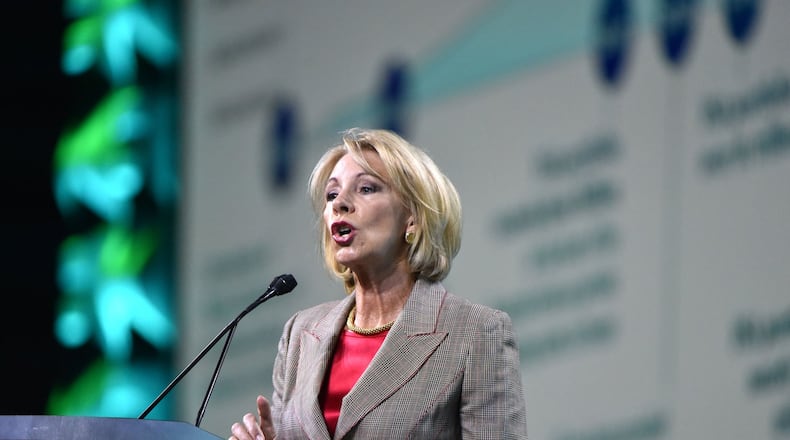Since 2007, the amount of student loan debt held by the federal government has tripled, from about $500 billion to an estimated $1.5 trillion, according to the federal government’s top education official.
U.S. Education Secretary Betsy DeVos warned an audience in Atlanta on Tuesday that this is a national problem.
“We have a crisis in higher education,” DeVos said at the start of a four-day Federal Student Aid (FSA) training conference, held at the Georgia World Congress Center. “Our higher ed system is the envy of the world, but if we, as a country, do not make important policy changes in the way we distribute, administer and manage federal student loans, the program on which so many students rely will be in serious jeopardy.”
DeVos also told the audience that 43 percent of student loans are considered in “distress,” meaning they’re delinquent, at risk of default or students aren’t paying enough on their loans.
In Georgia, like much of the nation, students are borrowing more to attend school. In 2010-11, students who graduated from some of Georgia’s top public colleges, such as the University of Georgia or Georgia Tech, borrowed an average of $16,705, according to a recent Southern Regional Education Board report. In 2015-16, the average amount borrowed was $21,907, the report found, a 31 percent increase.
State funding per student to public colleges in Georgia and many states has also declined since the last decade, and college costs have increased. The average state funding per student in the University System of Georgia has declined from $8,191 in fiscal year 2009 to $7,541 per student this fiscal year, according to state data. The average price of attendance at a state school swelled from $8,361 a year in 2006 to $14,791 in 2016, a 77 percent increase, a state auditor report found.
In response to concerns about rising costs and debt, the state's Board of Regents voted earlier this year not to raise tuition this school year. University System of Georgia Chancellor Steve Wrigley announced last month plans to improve financial transparency for students that include developing detailed student aid award letters and the cost of not taking a full load of courses.
DeVos said a national conversation is needed about college costs. Educators, she said, should talk more with students about which educational pathways are best and be upfront with students about their loans, and the federal government must be a more responsible lender. DeVos said her office is working on efforts to be more transparent about debt, such as sharing information with students about how much they owe, likely on a mobile app her office recently created that DeVos promoted in her speech Tuesday.
She put some blame for the rising loan costs on the Obama administration, saying it conducted a “government takeover of student lending” in 2010.
“[A]s you know, in 2010 under the guise of helping expand the Pell grant program and paying for Obamacare, the previous administration federalized the student loan portfolio,” DeVos told the audience. “That move was paired with a consistent drumbeat of not-so-subtle signals that a traditional four-year college degree is the only path to and measure for success.”
Terry Hartle, who’s been involved in these issues for more than two decades, said he agreed with DeVos about her concerns that some colleges don’t clearly inform students about the loan process. Hartle, senior vice president for the Washington, D.C.-based American Council on Education — which represents about 1,700 college and university presidents — disagreed that the system is in crisis mode. He noted the default rate is 10.8 percent and that the Obama administration effort in 2010 to be more involved in borrowing without subsidies to private lenders for federally-backed loans was saving the government money.
“The fact is for the vast majority of borrowers … they will pay back their loans with minimal difficulty,” Hartle said.
The U.S. Department of Education has been in an ongoing legal battle concerning student loan forgiveness rules implemented during the Obama administration. A federal judge recently ruled the department must follow the Obama administration guidelines, which allow students to have their federal student loans forgiven if a school employed illegal or deceptive practices to encourage the students to borrow to attend the school. DeVos has proposed a new formula, calling the Obama-era rules confusing to schools and students and costly to the department.
Paying for college in Georgia
Average borrowed: 2010-11, $16,705; 2015-16, $21,907
Funding per student: 2009, $8,191; this year, $7,541
Cost of attending: 2006, $8,361 a year; 2016, $14,791
Sources: Southern Regional Education Board, state data
About the Author
Keep Reading
The Latest
Featured


